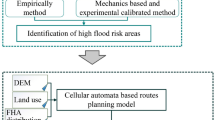Abstract
In order to enhance the authenticity and accuracy of passenger evacuation simulation in ships, a new multi-grid model was proposed on the basis of a traditional cellular automata model. In the new model finer lattices were used, interaction of force among pedestrians or between pedestrians and constructions was considered, and static floor fields in a multi-level exit environment were simplified into cabin and exit static floor fields. Compared with the traditional cellular automata model, the multi-grid model enhanced the continuity of the passengers’ track and the precision of the boundary qualifications. The functions of the dislocation distribution of passengers as well as partial overlap of tracks due to congestion were realized. Furthermore, taking the typical cabin environment as an example, the two models were used to analyze passenger evacuation under the same conditions. It was found that the laws of passenger evacuation simulated by the two models are similar, while the simulation’s authenticity and accuracy are enhanced by the multi-grid model.
Similar content being viewed by others
References
Bradley GE (1993). A proposed mathematical model for computer prediction of crowd movements and their associated risks. In: Smith RA, Dickie JF, editors. Engineering for crowd safety. Elsevier, Amsterdam, 303–311.
Burstedde C, Klauek K, Schadschneider A, Zittartz J (2001). Simulation of Pedestrian dynamics using a two-dimensional cellular automaton. Physica A, 295(3–4), 507–525.
Fang Zhiming, Song Weiguo, Xu Xuan (2008). Analysis of single-room evacuation with multi-grid model. Fire Safety Science, 17(3), 165–171.
Guo Renyong, Huang Haijiang (2008). A mobile lattice gas model for simulating pedestrian evacuation. Physica A, 387(2–3), 580–586.
Helbing D, Molnar P (1995). Social force model for Pedestrian dynamics. Physical Review E, 51(5), 4282–4286.
Helbing D, Farkas I, Vicsek T (2000). Simulating dynamical features of escape panic. Nature, 407, 487–490.
Helbing D, Keltseh J, Molnar P (1997). Modelling the evolution of human trail systems. Nature, 388, 47–50.
Kirchner A, Schadschneider A (2002). Simulation of evacuation processes using a bionics-inspired cellular automaton model for pedestrian dynamics. Physica A, 312(1–2), 260–276.
Kirchner A, Nishinari K, Schadschneider A (2003). Friction effects and clogging in a cellular automaton model for pedestrian dynamics. Physical Review E, 67, 056122.
Kirchner A, Klupfel H, Nishinari K, Andreas S, Michael S (2004). Discretization effects and the influence of walking speed in cellular automata models for pedestrian dynamics. Journal of Statistical Mechanics: Theory and Experiment, P10011.Masakuni Muramatsu, Takashi Nagatani (2000). Jamming transition of pedestrian traffic at a crossing with open boundaries. Physica A, 286, 377–390.
Song WG, Yu YF, Wang BH, Fan WC (2006a). Evacuation behaviors at exit in CA model with force essentials: a comparison with social force model. Physica A, 371(2), 658–666.
Song Weiguo, Xu Xuan, Wang Binghong, Shunjiang Ni (2006b). Simulation of evacuation processes using a multi-grid model for pedestrian dynamics. Physica A, 363(2), 492–500.
Weng WG., Pan LL, Shen SF, Yuan HY (2007). Small-grid analysis of discrete model for evacuation from a hall. Physica A, 374(2), 821–826.
Yue Hao, Guan Hongzhi, Zhang Juan, Shao Chunfu (2010). Study on bi-direction pedestrian flow using cellular automata simulation. Physica A, 389(3), 527–539.
Author information
Authors and Affiliations
Corresponding author
Additional information
Foundation item: Supported by the Ph.D Programs Foundation of Ministry of Education of China under Grant No.201023041108 and the Fundamental Research Funds for the Central Universities under Grant No.61004008.
Miao Chen was born in 1983. She is a PhD candidate at Harbin Engineering University of China. Her current research interests include passenger evacuation simulation in ships and ship design.
Duanfeng Han was born in 1966. He is a professor at Harbin Engineering University of China. He is also a PhD advisor in the College of Shipbuilding Engineering. Currently, his main research interests include digital ship building, HOV design, virtual reality for ships, and many other research topics. Passenger evacuation in ships is a partial work of virtual reality for ships. In recent years, he has published more than 30 papers, two patents, and two books.
Haipeng Zhang was born in 1981. He is a PhD candidate at Harbin Engineering University of China. His current research interests include digital measurement for hull blocks and ship design.
Rights and permissions
About this article
Cite this article
Chen, M., Han, D. & Zhang, H. Research on a multi-grid model for passenger evacuation in ships. J. Marine. Sci. Appl. 10, 340–346 (2011). https://doi.org/10.1007/s11804-011-1078-x
Received:
Published:
Issue Date:
DOI: https://doi.org/10.1007/s11804-011-1078-x




